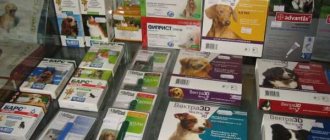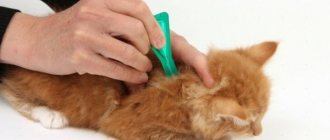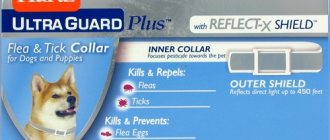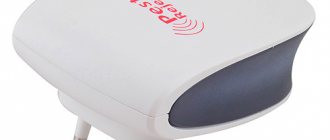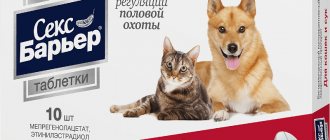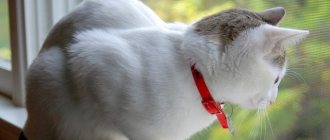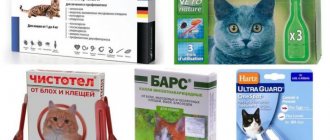Advantages and disadvantages of funds
Each insecticide has its own characteristics. Their difference may be in the speed of action, toxicity, and rules of use. To understand what is more effective against fleas, drops or a collar, you need to study their advantages and disadvantages.
Collar
This tool has the following advantages:
- The collar is easy to use;
- its use is quite convenient if the pet does not like to bathe;
- certain models can be worn by pregnant animals, kittens and puppies;
- the neck tape contains a substance that is safe for cats or dogs;
- fleas cannot fight the insecticidal component, so your pet can easily shake it off;
- The validity of the tape lasts from two to seven months if the animal wears it regularly;
There are also disadvantages of the collar:
- if the pet is too active, it can get injured simply by getting caught;
- the service life is reduced if it gets wet regularly;
- The effectiveness of this product directly depends on the climatic conditions where it is used.
Drops
This form of the drug consists of various types of insecticides. They have a moderate degree of toxicity. It is recommended to use anti-parasite drops only for adult pets.
This will allow you not to endanger the health of puppies and kittens, who may become poisoned after treatment.
The advantages of drops, comparing them with other similar products, include:
- best efficiency;
- the need to treat not the entire animal (dripping onto the withers);
- safety for pets.
The downside of the drops is that the protective effect does not exceed one week. Constant treatment of the animal leads to the fact that the parasites adapt to insecticides of a certain type and stop responding to them.
The active ingredient in the drops should be changed periodically. It is not recommended to use drops for flea prevention.
There is another drawback to drops. The owner must limit the pet's physical activity immediately after treatment. He will not be able to lick off the product that has not yet been absorbed.
How to remove fleas from a cat
- Treatment against fleas and ticks in cats should be carried out at least once every 3 months, and if your cat is outdoors and in contact with other animals, then at least once every 1-2 months.
- 3 days before and 3 days after the procedure, bathing the animal is prohibited, unless this is required by the method of applying some drops to the withers.
- It is important to use products designed specifically for cats. Because some anti-flea medications for dogs are toxic to felines.
- Without consulting a specialist, you should not use flea and tick medications on newborn kittens, pregnant and lactating cats, as well as weakened and sick animals.
- After treating the fur with sprays and drops, do not let the animal lick itself for about half an hour. To be safe, use an Elizabethan collar - this way the cat will definitely not be able to lick anything.
- It is necessary to treat not only the pet with special products, but also the places where it sleeps (house or lounger) and plays (play set, scratching post). It is also important to thoroughly vacuum surfaces that cannot be washed: sofas, armchairs, ottomans, carpets.
How to use flea treatments correctly
The effectiveness of flea medicine is influenced by the correct use of it, namely:
- three days before and three days after treatment, you cannot bathe the cat;
- correct application of the product not to the cat’s fur, but to the skin in the withers area and along the part of the spine that the animal cannot lick;
- maintaining the correct dosage of the drug.
The dosage is calculated based on the weight and age of the animal in accordance with the recommendations on the packaging of a particular product.
Do not exceed the recommended dosage - the products are toxic!
To effectively control fleas, you should take into account the life cycle of these insects and know that on average, 5% of adult fleas live on a cat.
Flea eggs (50%), larvae (35%) and pupae (10%) are found not only on the animal’s body, but also in the environment. That is why it is necessary to treat not only the animal, but also its habitat. It is best to completely replace the bedding and all care items.
Further in the article we will look at the types of flea products and their popular brands. Let's compare their characteristics and prices. Let's talk about traditional methods of fighting parasites.
How to get rid of fleas on a pregnant or lactating cat
Excellent health of a pregnant or lactating cat is a prerequisite for the birth of a healthy and viable litter. Fleas not only release toxins into the animal's blood, forcing the cat to scratch the bite sites, but also increase the risk of infection with helminths, as well as a number of infectious diseases.
The use of standard treatments in this situation should be approached with extreme caution; flea sprays, drops or other drugs may have a negative effect on fetal development or affect the quality of milk.
One of the most effective and simplest methods is to simply wash the cat while combing the fur with a fine-toothed comb. If you find fleas between the teeth of the comb, you should rinse the tool with hot water.
This method of fighting parasites will require a fair amount of patience and perseverance from the owners, since the procedure requires regular frequent repetition and one cannot count on quick results.
Antiparasitic shampoos can be used to treat a nursing cat, but you should consult your veterinarian before choosing a product. When using such shampoos, special attention should be paid to rinsing the cat, since even slight residues of foam on the nipples can lead to health problems for kittens.
Do not neglect folk remedies. For example, a decoction of rosemary applied to a cat’s fur significantly reduces the number of parasites. An excellent remedy for fleas is wormwood, and you can use a fresh plant, dried or wormwood oil. Wormwood does not kill fleas, but its smell can repel parasites.
Criterias of choice
To decide whether to buy a flea collar or anti-flea drops for your pet, you need to consider the following criteria:
- pet's age and weight. Manufacturers provide instructions that describe the rules for using insecticidal substances. Insect collars are allowed for animals over two months of age. The tapes have different lengths. You need to select it taking into account the volume of your pet’s neck. They are produced in lengths from thirty-five to forty centimeters. The tapes are regulated by a special fixing device. Do not tighten the collar too tightly. The distance between the neck and the tape should be at least two centimeters;
- absence of any contraindications for use. If the owner does not have such information when purchasing drops, then a test must first be performed. A small amount of the solution is dripped onto the animal’s withers, and it is observed whether the body reacts to the insecticide. This criterion also applies to collars. When the animal wears it for some time, you need to check its skin in the neck area. If allergic reactions appear there, or the hair begins to fall out, select a ribbon from another manufacturer;
- the effectiveness of the drugs, taking into account the climatic conditions in which the pet lives.
How the collar works
They are divided into destructive, repellent and ultrasonic. The first are products that have antiparasitic properties due to the insectoacaricides they contain.
What substances will be combined in a particular collar are determined taking into account:
- their lack of conflict with each other;
- safety, resistance to environmental factors.
The collar tape contains a product that penetrates the animal's fur very slowly. This allows them to serve as protection against fleas for a long time. There is no need to put the device on an animal that is sick or weakened. This may make the situation worse.
Repellent collars help repel parasites. It is impossible to destroy fleas already on an animal's fur using these products. They are designed to protect the animal from attack by parasites.
The smell of various essential oils that the tape emits does not irritate the nasal receptors of the pet or the people around it.
Such means need to be changed more often than destructive ones. Essential oils evaporate quickly. The defense may weaken, and the pet will be subject to a flea attack.
Anti-flea ultrasonic collars emit electromagnetic waves that pose no danger to warm-blooded animals, but repel parasites. The product is equipped with a battery-powered translator.
Before you put on the collar, you need to remove the fleas completely. This device only protects the pet, preventing parasites from attacking it again.
Video
How to use the Rolf Club 3D flea and tick collar
Sprays and aerosols for fleas and ticks for dogs and cats
Sprays and aerosols against ectoparasites are produced by the same manufacturers as drip products. Their composition and combination of components are often the same as drops, with the only difference being that in sprays and aerosols the oil base is present to a lesser extent. They are more liquid. They should be applied against the animal's fur, completely over the entire surface of the body, avoiding contact with the mucous membranes of the mouth, nose and eyes. After spraying for 40-60 minutes, the animal should dry on its own; It is not advisable to dry it with a hairdryer or other active means.
Sprays have an immediate effect, so they can be successfully used to treat the animal’s premises and resting place. It is also convenient to use a flea and tick spray as an addition to drip medications or collars when traveling to the forest or just on vacation, if there is likely to be a high probability of an ectoparasite attack there. Insectoacaricidal sprays have their effect within 15-20 minutes with a maximum guaranteed effect for several days. In the future, their properties gradually dry up, so the manufacturer recommends treating once every 14 days, but, in fact, sometimes more frequent application is required - once every 7-10 days. In any case, this type of protection for cats and dogs from fleas and ticks should be used in emergency and unexpected situations when quick and high-quality protection is required for a relatively short period of time.
The main disadvantages of aerosols and sprays are their certain danger when licking and swallowing the drug, high consumption of the product in large animals and difficulty in processing in long-haired breeds of cats and dogs.
Products based on fipronil can be used on small animals and puppies from 1.5 months of age, and can also be combined with fipronil drops to treat the inner surface of the ears, interdigital space, abdomen and jowls. This is especially true for animals that love to swim.
Sprays containing pyrethroids are more toxic and dangerous for animals, and less persistent in the environment. It is advisable to apply them once every 5 days. Use in cats and dogs from 8 weeks of age, avoiding contact with mucous membranes. Do not use by pregnant, lactating, sick or weakened women, do not allow licking.
Of the variety of sprays and aerosols, Frontline, Fipronil, Bolfo and Hartz are considered the most effective.
Operating principle of drops
The effect of the drops is similar to that of flea collars, but they begin their work in the sebaceous glands of the pet’s epidermis. They consist of several components that help mutually enhance each other's effects.
Once on the fur, the drug begins to be absorbed and creates a supply of insecticides in the animal’s skin. Trying to find the site of the bite, the parasites touch substances that are fatal to them.
The most tenacious individuals try to bite the pet. This leads to their final death.
The owner must accurately calculate the dosage of drops needed to eliminate fleas from his pet. This will help avoid allergic reactions and poisoning. Animals easily tolerate the use of drugs if you follow the instructions for use.
Combination of different flea and tick medications for dogs and cats
If we talk about the combined use of several insectoacaricidal agents at the same time - drops, sprays and a collar, then there are two opinions. Often, when mixing two drugs from different groups and different manufacturers, it is possible to develop negative reactions in the form of allergies and intoxication, which are difficult to respond to standard therapy. However, in high-risk situations where there is a high likelihood of flea and tick infestation, especially in nature, it is possible to use drops, sprays and collars with matching or complementary ingredients. It is desirable that these are products produced by the same company. For example, collars are supplemented with drops or sprays. If the animal was treated with drops more than 3 weeks ago and is wearing a tick and flea collar, then when traveling in nature, a single application of the spray to certain areas of the body is allowed (you don’t have to treat the animal completely), etc. The options are different.
From March to October, pets should be especially carefully protected from ticks, fleas and flying insects. Antiparasitic collars and drops are the most popular and effective treatments. Veterinarians often recommend products such as the Foresto® collar and Advantix® drops. The main advantage of these drugs is maximum protection of the animal from dangerous tick and insect bites due to its repellent effect. The choice between drugs can be made depending on the pet’s habitat: for active dogs who often walk in nature, in the forest and near water bodies, the Foresto® waterproof collar with long-term protection of up to 8 months is suitable, and for pets who prefer city parks and trips out of town for weekend - Advantix® drops.
When using topical insectoacaricidal preparations, you should follow some rules:
- Purchase medications from trusted pet stores, veterinary pharmacies or clinics.
- Please read the instructions carefully. Determine the dosage based on the weight of the animal, the period of guaranteed protection, contraindications, etc.
- Initial treatment should be done in early spring.
- Be sure to apply the preparations to the animal’s skin; treating the fur alone will not bring the desired result.
- Do not violate the terms of repeated treatments, individual for each drug.
- Do not apply the product to damaged or damp skin. Strictly follow the recommended dosages.
- Do not bathe 3-5 days before and after treatment. If the animal bathes frequently, especially in the summer, the interval between treatments can be reduced. This also applies to changing the collar.
- When going outdoors, treat the animal 2-3 days before the intended trip, since many products do not begin to act immediately.
- With caution and as a special exception, use several insectoacaricides with different active ingredients to protect the animal. When treating with drops, you can additionally apply sprays to areas where the effect of drops may not be available in the coming days (dewlap, paws and stomach). Use products from the same active ingredient and manufacturer. The combination of fipronil and propoxur is possible. Remember that many drugs should never be combined together (ivermectin and diazinon).
- Maintain personal hygiene when processing an animal, as some components of insectoacaricidal agents can, under certain conditions, cause harm to humans. Keep medications out of the reach of children.
- At the first symptoms of intoxication in an animal, presumably caused by the use of insectoacaricidal agents (increased salivation, trembling, shortness of breath and constriction of the pupils), immediately consult a veterinarian.
Features of the funds
The purposes for which a collar or anti-parasite drops are used are the same. They are safe for animals. If he has a lot of fleas, it is quite difficult to fight them.
The collar is best used for prevention purposes, or to destroy a small number of parasites. It should not be removed so that the pet is not left without protection.
Anti-parasite drops have a broader effect. The selection of the required dosage must be carried out carefully (especially if it is necessary to remove parasites from a young animal). When a pet is infected with fleas, it is enough to drop the drug once on the withers for it to begin its insecticidal effect.
How long it will last can be read in the instructions for the drug. For prophylactic purposes, the use of drops is not recommended. After removing fleas from your pet, it is better to buy him a protective collar.
How to use tick repellent tablets correctly?
It is important to read the instructions for anti-tick medications carefully and thoughtfully. Estimate exactly what weight the tablets are designed for, at what age dogs can use them, for how long the manufacturer guarantees protection against ticks, and whether it is suitable for pregnant and lactating bitches. You can buy Bravecto anti-tick tablets for dogs weighing 2-4, 5 kg, 4.5-10 kg, 10-20 kg, 20-40 kg, 40-56 kg. For dogs weighing more than 56 kg, a combination of tablets is used at the rate of 25-56 mg of fluralaner per 1 kg of animal weight. Breaking tablets is not allowed.
Inspect your pets regularly, and also use combined methods and other medications to maintain the repellent (deterrent) effect!
Health to you and your pet!
Popular questions
Pet owners have a huge number of questions regarding insecticides for fleas.
To make a choice, consider the most popular of them:
- What flea treatment is suitable for small puppies and kittens so as not to endanger their health? – Each owner has the right to decide for himself which insecticide to choose. However, it is better to use a collar or drops that have acceptable age restrictions for puppies and kittens;
- Are flea drops allowed for pregnant and lactating animals? – They are allowed if the owner strictly follows the instructions for use. Exceeding the dosage of the product can harm your pet and its future offspring.
When faced with the appearance of fleas on a pet, it is necessary to take immediate action. Parasites can multiply very quickly, and it will be more difficult to remove them.
When selecting an insecticide, you need to take into account their advantages and disadvantages. In order to no longer encounter the appearance of fleas, preventive measures are carried out by putting a repellent collar on the animal.
Folk remedies for fleas
Please note that we found these recipes freely available on the Internet - we did not personally check them and are presented for your reference only.
Remember that folk remedies for fleas on cats are not proven effective and may be more toxic than those sold in pet stores.
- Table salt is dissolved in a bowl of warm water. The ratio of water and salt is approximately 50 g of salt per 1 liter of water. The cat needs to be carefully dipped into this salty water up to its neck. Leave for 5 minutes and then rinse the animal with clean warm water, dry thoroughly and comb out with a comb.
- Crush 7 cloves of garlic and pour 700 ml of water over them. Leave the resulting mixture overnight, and in the morning rub it into the withers area so that the cat cannot lick off the product.
- A decoction of two herbs, tansy and wormwood, also has a negative effect on fleas. Take wormwood and tansy in equal proportions and brew in a water bath. When the broth has cooled, it should be rubbed into the pet’s skin over the entire back. Then wrap the cat in a towel and keep it there for 30 minutes.
- Many people recommend a decoction of wormwood as an effective remedy for fighting fleas in cats. To prepare this remedy, you need to take 20 grams of dry wormwood or 40 grams of fresh wormwood. The herb is poured with two glasses of water and boiled over low heat. Then the broth is allowed to cool and the resulting product is applied to the animal’s fur using a cotton swab.
- If your pet loves beds and pillows, then you can prepare him a therapeutic mattress. To do this, take pine sawdust and fill a small pillowcase with it. For greater efficiency, you can add several branches of wormwood to the sawdust. This recipe has a more preventive effect.
Garlic and wormwood are very toxic to cats!
